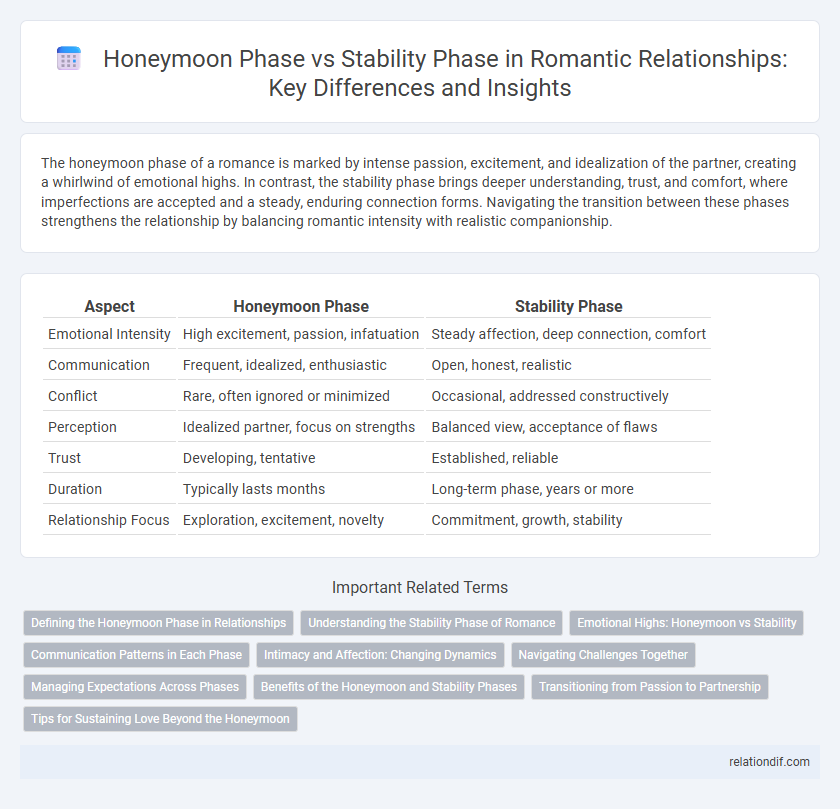The honeymoon phase of a romance is marked by intense passion, excitement, and idealization of the partner, creating a whirlwind of emotional highs. In contrast, the stability phase brings deeper understanding, trust, and comfort, where imperfections are accepted and a steady, enduring connection forms. Navigating the transition between these phases strengthens the relationship by balancing romantic intensity with realistic companionship.
Table of Comparison
| Aspect | Honeymoon Phase | Stability Phase |
|---|---|---|
| Emotional Intensity | High excitement, passion, infatuation | Steady affection, deep connection, comfort |
| Communication | Frequent, idealized, enthusiastic | Open, honest, realistic |
| Conflict | Rare, often ignored or minimized | Occasional, addressed constructively |
| Perception | Idealized partner, focus on strengths | Balanced view, acceptance of flaws |
| Trust | Developing, tentative | Established, reliable |
| Duration | Typically lasts months | Long-term phase, years or more |
| Relationship Focus | Exploration, excitement, novelty | Commitment, growth, stability |
Defining the Honeymoon Phase in Relationships
The honeymoon phase in relationships is characterized by intense passion, frequent excitement, and heightened emotional connection, often lasting from several months up to two years. During this period, couples experience idealization of each other, increased dopamine and oxytocin levels, and a focus on shared positive experiences. This stage contrasts with the stability phase, where emotional bonds deepen, communication patterns stabilize, and partners develop realistic expectations and long-term commitment.
Understanding the Stability Phase of Romance
The stability phase of romance marks a shift from the intense passion of the honeymoon phase to a deeper, more enduring connection built on trust, communication, and shared experiences. Couples develop emotional intimacy and mutual respect, which strengthens their bond beyond initial infatuation. This phase emphasizes realistic expectations, emotional support, and long-term commitment as foundations for lasting love.
Emotional Highs: Honeymoon vs Stability
Emotional highs during the honeymoon phase are marked by intense passion, excitement, and idealized perceptions of a partner, driven by heightened dopamine and oxytocin levels. In the stability phase, emotional intensity shifts towards deeper attachment, trust, and comfort, supported by increased production of vasopressin and oxytocin, fostering long-term bonding. Understanding this transition helps couples appreciate evolving emotional experiences and build resilient relationships.
Communication Patterns in Each Phase
During the honeymoon phase, communication patterns are characterized by frequent, idealized exchanges focused on positivity and mutual admiration, fostering emotional closeness and excitement. In the stability phase, conversations often shift to more realistic, practical topics with increased transparency, conflict resolution, and deeper understanding, reflecting mature emotional bonding. Effective communication in both phases is crucial for sustaining relationship satisfaction and long-term connection.
Intimacy and Affection: Changing Dynamics
During the honeymoon phase, intimacy and affection are often intense and frequent, fueled by novelty and heightened emotional connection. In the stability phase, these expressions become more consistent and grounded, reflecting deeper trust and understanding between partners. The shift allows couples to develop a mature bond where affection is less about exhilaration and more about enduring closeness.
Navigating Challenges Together
During the honeymoon phase, partners experience intense emotions and idealized perceptions that often mask underlying conflicts, making challenges seem less significant. The stability phase requires couples to develop effective communication, empathy, and problem-solving skills to navigate real-life difficulties and deepen their emotional bond. Successfully managing challenges together in this phase fosters long-term trust, resilience, and a more authentic, mature love.
Managing Expectations Across Phases
During the honeymoon phase, heightened emotions and idealized perceptions can create unrealistic expectations of constant excitement and perfection. Transitioning into the stability phase requires managing expectations by embracing deeper emotional intimacy, accepting imperfections, and fostering consistent communication. Understanding this shift helps couples build resilient relationships grounded in trust and realistic, mutual support.
Benefits of the Honeymoon and Stability Phases
The honeymoon phase in romance brings intense passion, excitement, and deep emotional connection, fostering intimacy and bonding that strengthen the relationship's foundation. The stability phase offers lasting trust, mutual respect, and effective communication, creating a secure environment for long-term growth and companionship. Together, these phases balance excitement with dependability, enhancing overall relationship satisfaction and resilience.
Transitioning from Passion to Partnership
The transition from the honeymoon phase to the stability phase in a relationship involves shifting from intense passion to deep partnership, where emotional intimacy and trust become the foundation. During this stage, couples prioritize communication, shared goals, and mutual support, fostering a sustainable and resilient bond. Understanding this evolution allows partners to navigate challenges with empathy, strengthening their connection beyond initial attraction.
Tips for Sustaining Love Beyond the Honeymoon
Sustaining love beyond the honeymoon phase requires consistent communication and genuine emotional intimacy, fostering trust and understanding over time. Prioritizing shared experiences and actively nurturing affection helps couples transition into the stability phase with deeper connection. Establishing rituals like regular date nights and expressing appreciation daily strengthens the bond and supports enduring romantic satisfaction.
honeymoon phase vs stability phase Infographic

 relationdif.com
relationdif.com